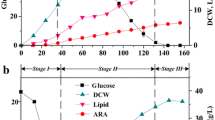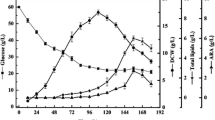Abstract
To achieve high production of arachidonic acid (ARA) through industrial fermentation of Mortierella alpina, the correlation between metal ions, mycelium pellet morphology and ARA production was investigated. By adding different metal ions to the culture medium, observing the morphological differences of mycelium pellet, total oil production and ARA content and established a correlation between them. The results showed that adding sodium ions increase the density of mycelium pellet, while reducing the diameter of mycelium pellet, resulting in a 41.59% increase in ARA production. Potassium ions, magnesium ions, calcium ions and iron ions slightly reduce the diameter of fungal hyphae and increase ARA production by 7.47%, 17.81%, 36.05% and 9.37%, respectively. At the same time, calcium ions promoted the branching growth of mycelium, which solve the problem of excessive free mycelium in fermentation broth within a certain concentration range. Zinc ions had a negative impact on bacterial growth, leading to the formation of mycelium clumps in the fermentation broth. Manganese ions and ferrous ions could transform the morphology of fungal mycelium into a smooth spherical surface, which was not conducive to the growth of M. alpina and the accumulation of oil. The comprehensive results showed that the optimal fermentation mycelium form for M. alpina was a dense central and loosely packed mycelium pellet. The yield of ARA was directly proportional to the density of mycelium pellet and inversely proportional to the diameter of mycelium pellet.



Similar content being viewed by others
References
Chang LL, Chen HQ, Tang X, Zhao JX, Zhang H, Chen YQ, Chen W. Advances in improving the biotechnological application of oleaginous fungus Mortierella alpina. Appl Microbiol Biotechnol. 2021;105:6275–89.
Chen XL, Zhou J, Ding Q, Luo QL, Liu LM. Morphology engineering of Aspergillus oryzae for L-malate production. Biotechnol Bioeng. 2019;116:2662–73.
Ercan K, Hasan BC, Irfan T. A current approach to the control of filamentous fungal growth in media: microparticle enhanced cultivation technique. Crit Rev Biotechnol. 2019;39(2):192–201.
Fejes B, Ouedraogo JP, Fekete E, Sándor E, Flipphi M, Soós A, Molnár AP, Kovács B, Kubicek CP, Tsang A, Karafa L. The efects of external Mn2+ concentration on hyphal morphology and citric acid production weremediated primarily by the NRAMP-family transporter DmtA in Aspergillus niger. Microb Cell Fact. 2020;19(17):2–11.
Fu YQ, Liu X, Zhou B, Jiang AC, Chai LY. An updated review of worldwide levels of docosahexaenoic and arachidonic acid in human breast milk by region. Public Health Nutr. 2016;19(15):2675–87.
Gu XY, Wang WS, Chen J, Zhao DD, Li LF. Optimization of fermentation conditions for Mortierella alpina, an arachidonic acid-rich oil producing fungus. Southwest China J Agric Sci. 2018;31(11):2300–6.
Iyyappan J, Baskar G, Bharathiraja B, Saravanathamizhan R. Malic acid productionfrom biodiesel derived crude glycerol using morphologically controlled Aspergillus niger in batch fermentation. Bioresourc Technol. 2018;9(2):10–1.
Jessie B, Nakamura MT, David WL. Differentiating the biological effects of linoleic acid from arachidonic acid in health and disease. Prostaglandins Leukot Essent Fatty Acids. 2018;135:1–4.
Jiang XW, Li H, Yang C, Xu YT, Luo XM. Progress in research of mycelial morphology control of filamentous fungiin submerged fermentation. Food Mach. 2016;32(9):209–10.
Kevin BH, Alan SR, Stewart F, Sheila G, Norman SJ. The essentiality of arachidonic acid in infant development. Nutrients. 2016;8(216):2–47.
Kurakake M, Hirotsu S, Shibata M, Takenaka Y, Kamioka T, Sakamoto T. Effects of nonionic surfactants on pellet formation and the production of β-fructofuranosidases from Aspergillus oryzae KB. Food Chem. 2017;224:139–43.
Li YH, Xu XZ. Research progress of filamentous fungi culture and its products. Biol Chem Eng. 2022;8(2):149–50.
Liu RS, Tang YJ, Bai FW. Regulatory mechanism underlying mycelium aggregation during filamentous fungi submerged fermentation. Chin J Biotechnol. 2019;35(5):749–58.
Luis DGM, Antonio IMJ, Ruan ZH, Carvalho JCD, Soccol CR. Industrial production, patent landscape, and market trends of arachidonic acid-rich oil of Mortierella alpina. Biotechnol Res Innov. 2019;3:103–19.
Luis DGM, Carvalho JCD, Antonio IMJ, Soccol CR. Production of arachidonic acid by Mortierella alpina using wastes from potato chips industry. J Appl Microbiol. 2020;130:1592–601.
Steven DH. Hyphal branching in filamentous fungi. Dev Biol. 2019;451:35–9.
Tao TL, Cui FJ, Chen XX, Sun WJ, Huang DM, Zhang JS, Yang Y, Wu D, Liu WM. Improved mycelia and polysaccharide production of Grifola frondosa by controlling morphology with microparticle Talc. Microb Cell Fact. 2018;17(1):2–10.
Tong LL, Wang Y, Du YH, Yuan L, Liu MZ, Mu XY, Chen ZL, Zhang YD, He SJ, Li XJ, Guo DS. Transcriptomic analysis of morphology regulatory mechanisms of microparticles to Paraisaria dubia in submerged fermentation. Appl Biochem Biotechnol. 2022;194:4333–47.
Veiter L, Rajamanickam V, Herwig C. The filamentous fungal pellet-relationship between morphology and productivity. Appl Microbiol Biotechnol. 2018;102(7):2997–3006.
Wang HC. Study on the mechanism of lipid synthesis and accumulation in oleaginous fungus Mortierella alpina. Wuxi: Jiangnan University; 2013.
Wu WJ, Zhang AH, Peng C, Ren LJ, Song P, Yu YD, Huang H, Ji XJ. An efficient multi-stage fermentation strategy for the production of microbial oil rich in arachidonic acid in Mortierella alpina. Bioresour Bioprocess. 2017;4:8.
Xu DD. Effects of metal lons on lipid production by fermentation with Mortierella and optimization of culture conditions. Huazhong University of Science and Technology; 2012.
Yang J, Jiao RH, Yao LY, Han WB, Lu YH, Tan RX. Control of fungal morphology for improved production of a novel antimicrobial alkaloid by marine-derived fungus Curvularia sp. IFB-Z10 under submerged fermentation. Process Biochem. 2016;51(2):185–94.
Zhang HD, Cui Q, Song XJ. Research advances on arachidonic acid production by fermentation and genetic modifcation of Mortierella alpina. World J Microbiol Biotechnol. 2021;37(4):2–9.
Zhang JG, Zhang JN. The filamentous fungal pellet and forces driving its formation. Crit Rev Biotechnol. 2015;36(6):1066–77.
Acknowledgements
This study is supported by the Scientific Research Fund Project of Education Department of Liaoning Province (LJKZZ20220060, LJKZ0514), Open Foundation of State Key Laboratory of Marine Food Processing & Safety Control (SKL202306).
Author information
Authors and Affiliations
Contributions
M.C., Y.B.F., and X.Z. designed the research. M.C. and Y.B.F., experimented and analyzed the data. X.Z. and X.F. participated in part of the experiments. M.C., Y.B.F., H.Y., X.Z., and X.F. wrote and revised the manuscript. All the authors discussed the results and approved the content of the manuscript.
Corresponding author
Ethics declarations
Conflict of interest
The authors declare that they have no conflict of interest to this work.
Human and animal rights
This article does not contain any studies with human participants or animals performed by any of the authors.
Informed consent
Informed consent was obtained from all individual participants in the study.
Supplementary Information
Below is the link to the electronic supplementary material.
Fig. S1.
Morphology of M. alpina mycelium under optimal addition of different metal ions. Control blank control. A1 2.0 g/L Na+. A2 2.0 g/L K+. A3 0.2 g/L Mg2+. A4 0.5 g/L Ca2+. B1 0.1 g/L Zn2+. B2 0.01 g/L Mn2+. B3 0.1 g/L Fe2+. B4 0.1 g/L Fe3+ (TIFF 17591 KB)
Fig. S2.
Scanning electron microscopy at 2000 × magnification to observe the surface of M. alpina mycelium pellet. Control blank control. A1 2.0 g/L Na+. A2 2.0 g/L K+. A3 0.2 g/L Mg2+. A4 0.5 g/L Ca2+. B1 0.1 g/L Zn2+. B2 0.01 g/L Mn2+. B3 0.1 g/L Fe2+. B4 0.1 g/L Fe3+ (TIFF 16905 KB)
Rights and permissions
Springer Nature or its licensor (e.g. a society or other partner) holds exclusive rights to this article under a publishing agreement with the author(s) or other rightsholder(s); author self-archiving of the accepted manuscript version of this article is solely governed by the terms of such publishing agreement and applicable law.
About this article
Cite this article
Feng, Y., Zhang, X., Yang, H. et al. Study on the regulation of Mortierella alpina morphology and high yield of arachidonic acid by metal ions. Syst Microbiol and Biomanuf (2024). https://doi.org/10.1007/s43393-024-00249-9
Received:
Revised:
Accepted:
Published:
DOI: https://doi.org/10.1007/s43393-024-00249-9




